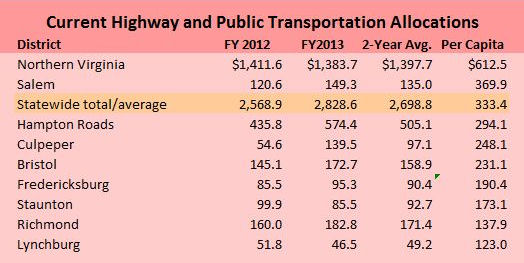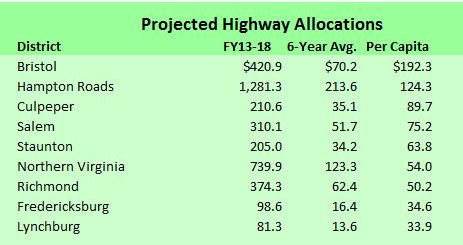Is your region of the state getting its fair share of transportation dollars? Lots of people would respond with a resounding, “No!” If they were all right, it would mean that there are no winners in the transportation sweepstakes, only losers, and that the Virginia transportation budget is the biggest black hole in the Milky Way galaxy this side of Sagittarius A.
But it may be necessary to re-think the old nostrum that all money flows to Richmond but little escapes its gravitational pull. Indeed, if the past two years are any indication, the Richmond transportation district (which extends to the North Carolina state line) has been sucking air while most of the money flows elsewhere.
The staff of the Richmond Regional Planning District Commission has tallied all the dollars allocated to the state’s nine transportation districts. Combining the numbers for the Virginia Department of Transportation (VDOT) and the Department of Rail and Public Transportation (DRPT), here’s what the construction numbers look like for FY 2012 and FY 2013:

While the Richmond MPO did not adjust construction dollars on a per-capita basis, I have done so in the chart above. Wonder of wonders, Northern Virginia has been allocated roughly four times per capita as much as the Richmond district. Only the Lynchburg district has fared worse.
Of course, that tells the story for only two years. District numbers swell for a year or two as money for mega-projects flow through the funding pipeline, then fall as the projects are completed. It can create a distorted image if you focus on a short period of time. Accordingly, the data crunchers in the Richmond MPO compiled the numbers for the Six Year Improvement Program for road and highway dollars (no rail). The results:

The rankings change a lot as Northern Virginia mega-projects wind down and mega-projects in Hampton Roads and Charlottesville (in the Culpeper district) ramp up. However, Richmond remains stuck in the basement with our friends in Lynchburg, although one could argue that the Charlottesville Bypass is really being spent for the benefit of Lynchburg and Danville, not Charlottesville, therefore it’s the Culpeper District that’s clapped in the fiscal dungeons.
Another reason those numbers don’t tell the whole story is that Richmond MPO staffers pulled out “statewide” projects that will benefit more than one region, such as the Interstate 95 HOV/HOT lane project, which will serve both the Northern Virginia and the Fredericksburg districts. And don’t forget, the green chart includes road construction dollars only. If it included rail and public transportation dollars, the allocations would be higher — and Northern Virginia and Hampton Roads, which get most of that money, would rise in the rankings.
Though interesting, these numbers won’t quell the kvetching. The Six Year Improvement Program is a shrunken remnant of construction budgets past. State dollars available for construction are expected to totally dry up by 2017 or 2018. One could argue that past construction spending, when money was more abundant, was far more beneficial to different regions of the state. According to political lore, Sen. Edward E. Willey, D-Richmond, who was the state majority leader back when Democrats treated the General Assembly as a private club, funneled many millions to pet projects in the Richmond region at the expense of other regions. But, then, Willey left the state Senate in 1983 — almost 30 years ago.
The Richmond region has received little special treatment since, argues Chuck Gates, communications director for the Richmond MPO. The General Assembly did offset some of the cost of the Rt. 288 bypass, but that was a fraction of the cost of mega-projects like the I-95/495 interchange and the Woodrow Wilson Bridge in Northern Virginia, he argues. “They threw a bone to us. But it’s been a decade since those decisions were made.”



